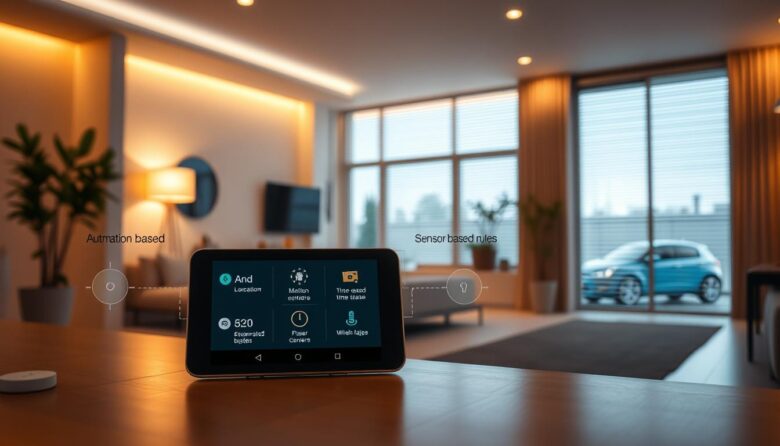Mobile applications are evolving beyond static functionality. Context-aware triggers now enable devices to respond intelligently to user patterns and environmental changes. This approach combines system-level data with predictive algorithms, creating seamless interactions that feel almost intuitive.
The Android framework provides built-in tools for understanding device states and user behavior. Its architecture allows apps to access real-time information about location, time, and resource availability. When paired with machine learning, these capabilities transform how applications adapt to dynamic conditions.
Developers can design systems that anticipate needs rather than react to commands. For example, an app might adjust notifications based on calendar events or optimize battery usage during travel. These decisions occur without manual input, leveraging the platform’s native capabilities alongside trained AI models.
This guide explores practical methods for integrating intelligent triggers into mobile solutions. It covers foundational concepts and implementation strategies, ensuring robust performance across diverse use cases. Readers will learn to balance system resources with responsive features while maintaining user privacy and device efficiency.
Understanding the Role of Android Context in App Architecture
Every Android app relies on a critical component that governs its interaction with device resources. The Context system operates as the backbone of this communication, linking software components to hardware capabilities and system services. This abstract class forms the foundation for secure data exchange and operational consistency across diverse devices.
System Communication and Resource Access
The android system uses Context to verify app identity during interactions with sensors, storage, and network interfaces. Developers retrieve locale-specific strings or device configuration details through Context methods, which automatically adapt to screen sizes and language settings. This ensures consistent user experiences across 10,000+ Android device models.
Managing Component Lifecycles
Proper handling of activity context and application context prevents memory leaks in long-running processes. Activities use context references to launch services or broadcast events, while system-managed instances handle background operations. Lifecycle-aware components automatically release resources when users switch apps or screens rotate.
Context permissions act as gatekeepers, blocking unauthorized access to sensitive data like location or contacts. The hierarchy between different context types becomes crucial when implementing predictive features – using the wrong context scope can disrupt AI model accuracy or drain battery life unexpectedly.
The Power of AI Logic in Android Automation
Modern apps now anticipate user needs through intelligent systems rather than waiting for direct commands. By merging machine learning models with device sensors and usage patterns, solutions become proactive partners in daily tasks. This shift elevates mobile experiences from reactive tools to predictive assistants.
Integrating AI with Contextual Triggers
The android system provides rich environmental data through its framework. Machine learning processes this information to activate features when specific conditions align. For example, apps might silence notifications during meetings detected via calendar integration or adjust screen brightness using ambient light sensors.
Developers train models to recognize patterns in user behavior. These systems analyze how people interact with apps at different times or locations. Over time, they predict actions like opening a navigation app when leaving work or launching music players during workouts.
Enhancing User Experience with Smart Decisions
AI-driven decisions consider multiple factors simultaneously. Battery levels, network strength, and device orientation all influence automated responses. The application context serves as a bridge between raw data and meaningful actions.
Adaptive interfaces demonstrate this intelligence. Themes might shift based on time of day, while notifications prioritize urgent messages during busy hours. Such features reduce manual adjustments while maintaining android development best practices for performance and privacy.
Overview of Android System Services and Binder IPC
At the core of every smart device interaction lies a complex network of system-level operations. Android system services handle critical tasks like managing app lifecycles and hardware access. These background processes operate in protected environments, ensuring stability across diverse devices.
Inter-Process Communication Fundamentals
The Binder IPC framework acts as a secure bridge between apps and system resources. It enables different processes to share data without direct access to memory. This approach prevents unauthorized modifications while maintaining performance efficiency.
Developers interact with services like ActivityManagerService through proxies created by Context.getSystemService(). These proxies use Binder IPC internally, translating method calls into messages sent via binder. The system_server process handles requests and returns results through the same communication channel.
Key services include WindowManagerService for display control and NotificationManagerService for alerts. Each operates through standardized interfaces, allowing consistent access across device manufacturers. This architecture supports real-time data exchange needed for responsive features.
Understanding these mechanisms becomes vital when implementing intelligent behaviors. Apps requiring sensor data or power management must efficiently navigate this layered structure. Proper use of system services ensures reliable performance without compromising security protocols.
Deep Dive into Activity, Service, and Receiver Contexts
Effective mobile experiences depend on precise management of operational environments. Three primary component types govern how apps interact with device resources: Activity, Service, and Broadcast Receiver contexts. Each plays distinct roles in managing visual interfaces, background tasks, and event responses.
Understanding Different Context Types
The activity context provides full access to UI elements and theme configurations. Built upon the application context, it handles window management and user interactions. However, its lifecycle aligns with screen visibility – destroyed when users navigate away.
For background operations, the service context enables long-running processes without visual elements. It maintains functionality even when apps aren’t active, making it ideal for AI systems analyzing sensor data over time. Developers must avoid mixing these scopes to prevent memory leaks.
Unique Challenges with Broadcast Receivers
Broadcast Receivers operate within tight constraints using ReceiverRestrictedContext. This temporary context exists only during event processing and blocks certain actions like starting services. Systems must complete tasks quickly or delegate them to persistent contexts.
Modern implementations often pair receivers with WorkManager or foreground services. This approach preserves context lifecycle integrity while executing complex AI decisions. Careful planning ensures automated features work seamlessly across all component types.
Implementing Context-Aware Triggers in Android Apps
Effective trigger systems in apps rely on layered architectural decisions. Developers must balance resource access with performance optimization while integrating intelligent decision-making processes. This tutorial demonstrates practical steps to build responsive features that adapt to changing conditions.
Foundation Setup and Resource Management
Start by defining base classes that handle multiple activity context types. Use lifecycle observers to track component states and prevent memory leaks. Establish communication channels through method calls between AI processors and system operations.
Create custom wrappers to manage the android context hierarchy. These wrappers control access to sensors and user data while respecting permission boundaries. Implement decision trees that evaluate device status, location patterns, and battery levels simultaneously.
Real-Time Adaptation Techniques
Design event-driven architectures using override fun in lifecycle-aware components. This approach lets triggers respond instantly to screen rotations or app switches. For example, a weather app could update forecasts when network connectivity improves.
Machine learning models process historical usage data through background services. Pair these models with creating new broadcast receivers that activate features based on time-sensitive triggers like calendar events.
Validation and System Integration
Test scenarios should simulate low-memory conditions and interrupted workflows. Use profiling tools to verify response times across device models. Integrate triggers into existing MVVM patterns by separating AI logic from UI controllers.
Maintain clean separation between decision engines and context providers. This structure ensures updates to one component don’t disrupt others. Regular audits prevent overconsumption of system resources while delivering personalized experiences.
context-based automation Android: Leveraging Component Types
Android’s architecture offers four core building blocks for creating adaptive solutions. Component types like Activities and Services form the foundation for responsive features. These elements work together to process data, manage interfaces, and respond to real-time events.
Activities handle user-facing operations with dynamic interfaces. They adapt layouts based on device orientation or time of day. Application components like Services operate behind the scenes, executing tasks during voice calls or while apps run in the background.
Broadcast Receivers monitor system-wide changes such as network fluctuations. They trigger actions when specific conditions occur, like enabling power-saving mode at 15% battery. Content Providers enable secure data sharing between apps, letting weather tools access calendar schedules for smarter suggestions.
Combining these elements creates systems that anticipate needs. A fitness app might use Services to track steps while Activities display progress. Receivers could adjust goals when detecting rainy weather through third-party data. This integration delivers smooth experiences without draining resources.
Developers achieve optimal performance by assigning clear roles to each component. Services handle heavy computations, Activities manage interactions, and Receivers monitor triggers. Proper coordination ensures features work harmoniously across diverse devices and usage scenarios.
Configuring Android Manifests for Context-Awareness
The AndroidManifest.xml serves as both blueprint and security layer for intelligent features. It defines how application components interact with device resources while enforcing privacy boundaries. Proper configuration ensures seamless operation of predictive systems without compromising user trust.
Declaring Components and Permissions
Developers must explicitly list all elements involved in smart workflows. Activities, services, and receivers require clear declarations with necessary permissions. Location access, sensor usage, and network capabilities appear here – critical for apps analyzing environmental patterns.
Lifecycle management extends to manifest entries. Persistent background operations need app process configurations that balance functionality with Android’s power-saving rules. Hardware requirements like GPS or biometric sensors also get specified at this stage.
Setting the android:exported Attribute
This security flag determines if external apps can interact with components. Since Android 12, elements with intent filters must declare export status explicitly. Systems handling sensitive data typically set this to “false” unless cross-app communication proves essential.
The component android architecture relies on these settings to prevent unauthorized access. Proper use maintains feature functionality while blocking potential exploits. Regular audits ensure alignment with evolving platform requirements and user expectations.



